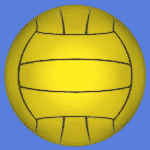Tactics
Contents
Defensive tactics
Two and two zone
'Two out'
Five out
Attacking tactics
Keeping possession
Circulation
Creating openings
Set piece attack 1 - 'Clear out'
Set piece attack 2 - 'Corner clear out'
Defensive Tactics
Here are my attempts at explaining some defensive tactics. It's all a bit idealised, but I think it's realistic enough. For now I've done some defensive arrangements: a four man zone/two and two, whatever you call it, a 'two out' arrangement and 'five-out'. Whites are the defending team, reds are the opposition (attacking) team.
It is likely that these tactics will merge into one another throughout a game,�but it's useful to treat them in isolation to get an idea of the common theme of being careful not to leave the opposition free to make easy passes and shots while trying to win possession to varying degrees, from a four man zone where the opposition are left to make the mistakes to a five out situation, where possession is actively won back.
Two and two
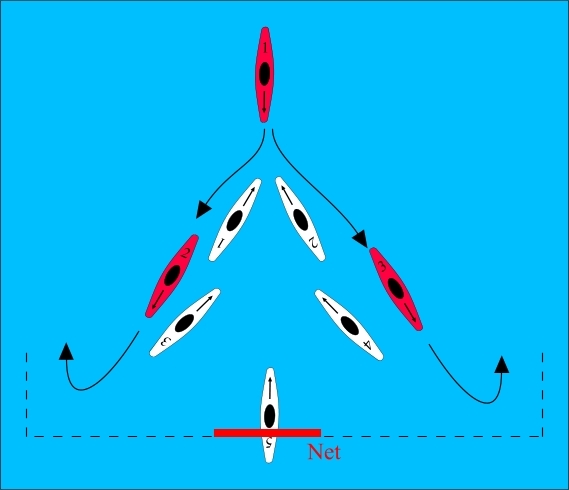
The defending team forms a 'Christmas tree' shape in front of the goal keeper.
- Attackers attempting to break through the front two defenders are sent round the side. The rear defenders keep the attackers facing away from goal and under pressure, so shots are at difficult angles and passes are difficult to receive. The aim is to force long-shots and errors from the attackers to win the ball back, while protecting the goal.
- Defenders shouldn't chase the ball, unless they are confident of winning it.
- Though a defender can start off positioned outside the 6m line, if they actively impede a player outside of the 6m line they will have committed an illegal jostle, ie given away a foul. The defenders must only jostle for position inside the 6m line as usual.
- Some examples of bad and good play are shown below.
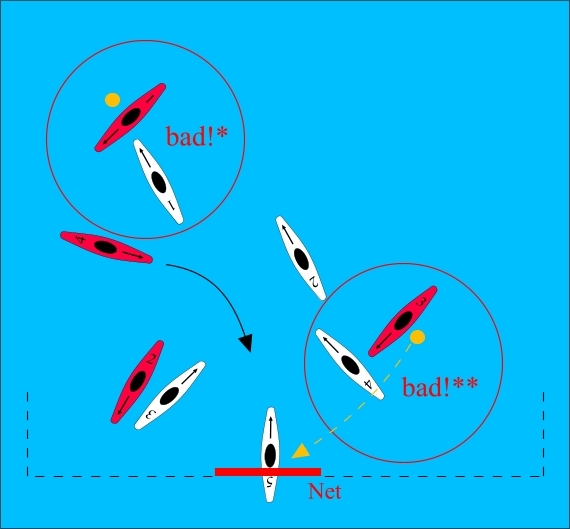
* Player 1 has left the formation to chase a ball which opposition player 1 has under control on the opposite side, leaving a gap for opposition player 4 to paddle into which could result on an undefended shot on goal.
** Player 4 has been lazy, and left opposition player 3 close to and facing goal, with the ball. Although player 4 and the keeper can attempt to block a shot with paddles, opposition player 3 is in close and has a better chance of scoring than they would if they had been turned away by player 4.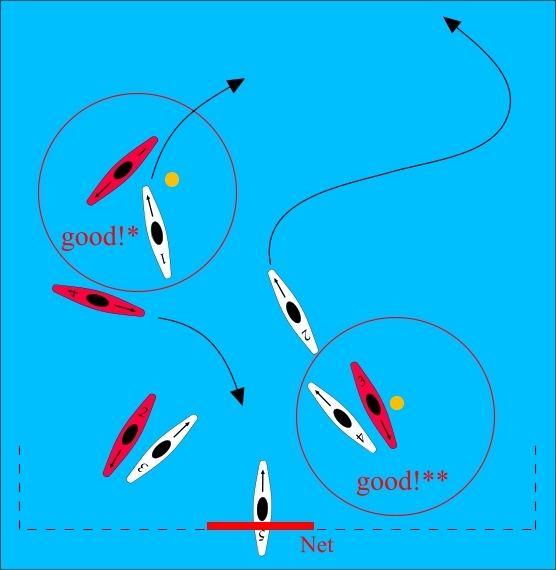
* Player 1 has left formation to intercept a loose ball, and has a good chance of winning it. Player 1 can dribble the ball on, while player 2 sprints up the pitch in support, paddling up the right wing then making a diagonal run towards goal such that a pass from player 1 can easily be received from the side, before shooting. Players 3, 4 and 5 can support, making sure they do not leave themselves open for a counter attack.
** Player 4 has put some effort in, turned opposition player 3 away from goal and ended up next to them, making a shot difficult, and putting opposition player 3 under pressure.
'Two out'
This is an attempt at something in between a four man zone and five out. When the game is perhaps 1-0 to the opposition, and a goal is required, but five out is considered too risky (perhaps the opposition are stronger and faster and are likely to get free and take advantage of an open goal.) Hopefully the diagrams below will explain some obvious good and bad actions, and some of the difficulties with this system.
- The two players in the zone�keep the attackers facing away from goal and under pressure, so shots are at difficult angles and passes are difficult to receive.
- The zone holds the opposition away from the goal in this way, while the two players chasing the ball attempt to win possession.
- Judgement is required by the two chasers on�whether to chase a ball and risk leaving a space behind, or keep the attackers occupied until the ball goes loose and possession can be won.
- The chasers should prevent the attacking players getting straight, unmarked runs on goal.
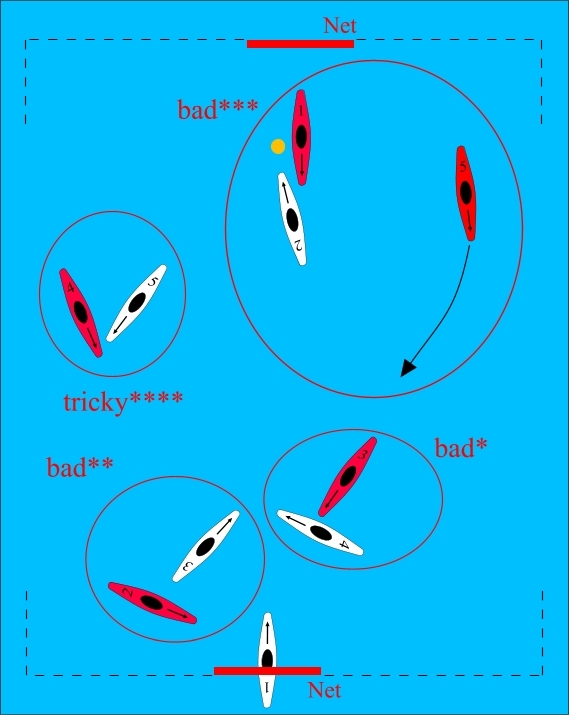
* Player 4 has been lazy, and left opposition player 3 close to and facing goal. Although player 4 and the keeper can attempt to block a shot with paddles, opposition player 3 is in close and if they receive a pass, they have a better chance of scoring than they would if they had been turned away by player 4.
** Player 3 has forgotten about opposition player 2 and allowed them a tight angled, but unobstructed view of goal, and is not guaranteed to be able to block a long looping pass from opposition player 1 which could result in a successful shot.
*** Player 2 has over-committed to chasing a ball which opposition player 1 can easily gather and pass on to opposition player 5, who is now left with a clear run towards goal. Opposition player 3 has player 4 occupied and could clear a gap for opposition player 5 to get a clear shot on goal.
****Player 5 is faced with a tricky decision of whether to stay marking opposition player 4 or whether to mark opposition player 5, either option leaves a player unmarked and able to receive a pass from opposition player 1. One option for player 5 is to loosely mark opposition player 4, while watching for a pass from opposition player 1 to opposition player 5 and be ready to respond. If the pass goes loose, player 5 might be able to pick it up. If it doesn't then they must decide what to do: go for opposition player 5 and try to tackle them and leave opposition player 4 unmarked, or stay with opposition player 4 and hope player 4 can hold off opposition player 5 as well as 3. Not ideal!!!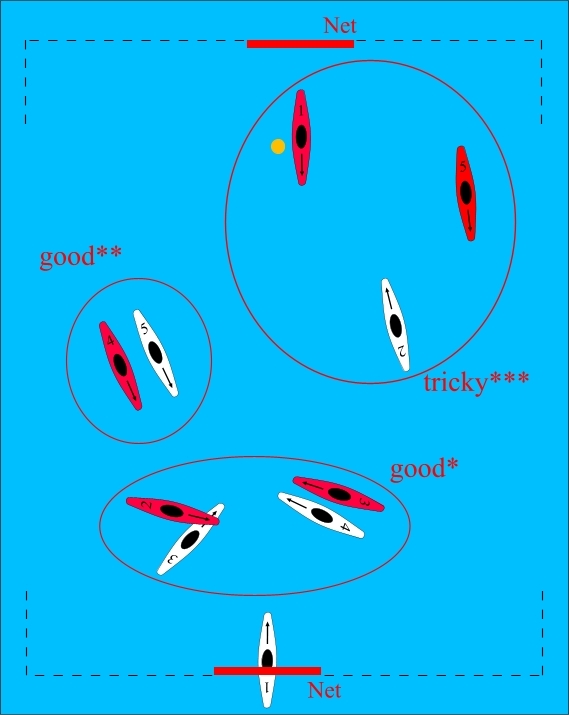
* Players 3 and 4 have kept opposition players 2 and 3 facing away from goal and under pressure.
** Player 5 is marking opposition player 4, is able to block a pass from opposition player 1 and is facing the same way as opposition player 4 so should be able to stay with them easily.
*** Player 2 is standing off and looking to force a pass from opposition player 1 while not leaving opposition player 5 unmarked. They can hope to block a pass with their paddles, or perhaps feign chasing opposition player 1 to force a pass to opposition player 5, but be ready to turn quickly and tackle opposition player 5. Again, this is not ideal and requires some skill and judgement, and probably some luck too!
Five out
Five out is where all five players each mark a player from the opposition. The aim of playing 'five out' is to put the opposition under pressure and get the ball back. You would need to do this if the opposition is in the lead, and is in possession, and you are unable to get the ball back otherwise.
- You have to work hard to stay next to your opponent at all times, without obstructing them (ie, pushing them around when they are not in possession and they are not inside the 6m line (see rules)). If a player is left free, it is likely that your goal is very vulnerable.
- Position your boat so it is facing the same way as the player you are marking (see diagrams below).
- Especially if the player is in range to shoot, keep them facing away from goal (again being careful to avoid obstruction) and keep on the goal-side of them, ie in between them and the goal (see diagrams below)
- If tackling the player, go under their boat since you run less risk of fouling, have more control and can get close for a push.
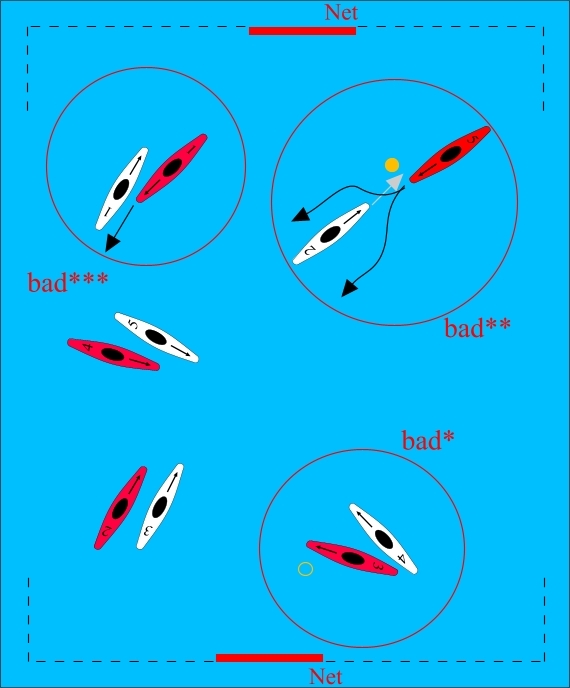
* Player 4 is not goal-side of opposition player 3. There is a chance that opposition player 5 can lob player 4, presenting opposition player 3 with a shot at an�open goal.
** Player 2 is going in to tackle player 5 facing the opposite direction to opposition player 5. This would be ok if the ball was a good distance from opposition player 5, however in this situation it is likely that opposition player 5 will get to the ball first and then 'skin' player 2 on either side. Opposition player 5 is then left free, unmarked, while player 2 is left in the corner having to turn round and catch up with opposition player 5.
*** Player 1 has been lazy and neither made sure they are facing the same way as opposition player 1 nor positioned themselves to block a pass from opposition player 5. It is easy for opposition player 1 to get free and receive a pass, while leaving their marker behind.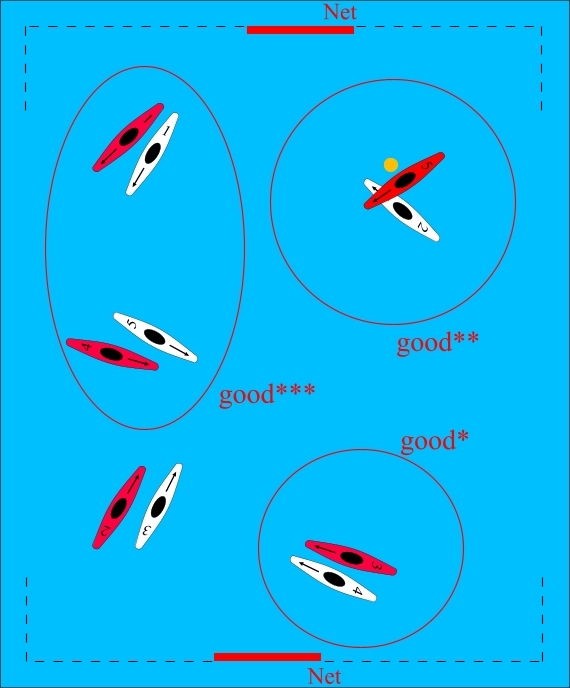
* Player 4 is goal-side of and facing the same way as opposition player 3. It is therefore difficult for player 3 to out-run player 4 since they will both be paddling forwards and if opposition player 5 passes to opposition player 3, a shot is awkward and player four has a chance of blocking it.
** Player 2 has gone under opposition player 5 to attempt a tackle, but remained facing about the same way as opposition player 5 so it is difficult for opposition player 5 to get away without being followed by player 2.
*** Players 1 and 5 are positioned such that they can block a pass from opposition player 5 to opposition players 1 and 4. Players 1 and 5 are also facing the same way as the opposition players they are marking, so escape is difficult!
Attacking Tactics
Here are my attempts at explaining some attacking tactics. Here I've tried to explain a collection of sensible team work, rather than set plays because I don't know any and I don't want to start making stuff up until I've tested it! This is presented as a bit of a collection of rules, but remember: "Rules are for the obedience of fools and the guidance of wise men"! Whites are the attacking team, reds are the opposition (defending) team.
I found a quote here (Clyde's Polo Page) which I think sums up the ideas here too:
"To be successful, you don't have to do extraordinary things. Just do ordinary things extraordinarily well."
Keeping possession
An unsuccessful shot, unless you are lucky and it touches one of the other team before it goes off, effectively hands the opposition the ball when you are in a vunerable position.
- Avoid shooting through more than one paddle (i.e. get one-on-one with the keeper or even better in front of an open goal), you might get lucky, but relying on luck is not the way forward!
- If you can't make a straight-forward, powerful, well placed shot because of your position, consider passing the ball to someone who can or someone who can recycle the ball until another opportunity comes.
- Avoid taking long-shots if the keeper is in position - the time it takes the ball to get there will give the keeper time to work out where it's going and block it. Get as close as possible.
- It is the job of the whole team to make sure the person with the ball has an easy pass available, lucky passes to people who are marked or through a marker's paddles might look good, but will more likely get intercepted.
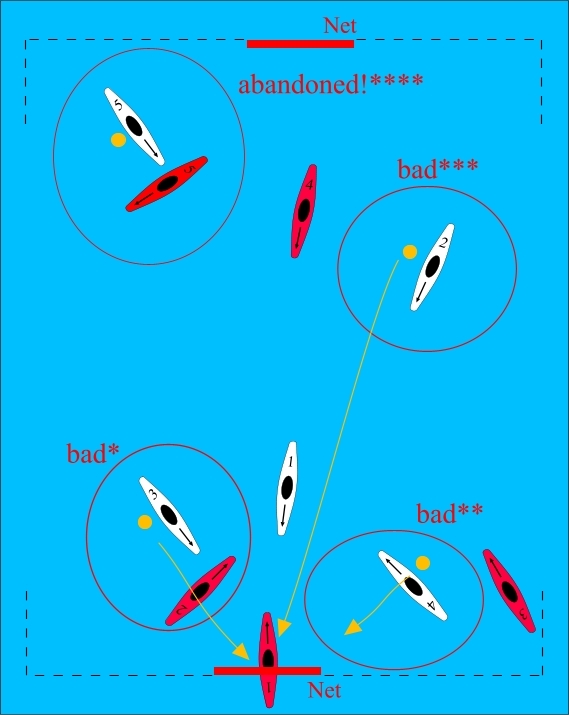
* Player three has tried to shoot past opposition player two and the goal keeper, both of whom are in a good position to block the shot.
** Player four has tried to take awkward shot across the body instead of passing the ball to player one who is facing goal, close in and so has a good position to shoot from.
*** Player two has taken a long shot, which the keeper then has ages to watch coming in and block, they are in position so can't be lobbed. The ball should be passed to player one.
**** Player five has been abandoned and the only passes open are through paddles or awkward, slow, high looping passes over player five who has a good chance of intercepting these too.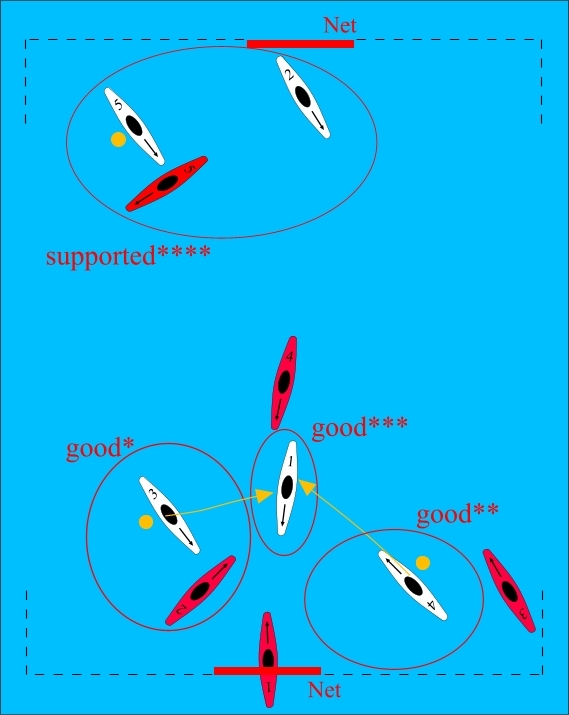
*Player three has passed the ball to player one, who is in a better position.
**Player four has passed the ball to player one, who is in a better position.
***Player one as maneouvred into a good position to receive a pass and shoot.
****Player two has moved into a position where they can support player five by receiving an easy pass, after which player five can get free of opposition player five.
Circulation
The attacking team should not leave themselves vulnerable to a counter attack.
- If a player from the back comes in to attack the defence of the opposition, a player at the front should paddle back to cover the gap they have left. In the extreme, if all five players paddle in to attack, as soon as the opposition get the ball they are presented with the opportunity for one person to break free, receive a pass and score an open goal.
- This requires communication, and awareness. If you are moving in to attack the opposition's defence, tell a player to come out and cover the gap you have left. Make sure you and your team mates are aware of what is going on, don't over-commit then blame them for not being psychic.
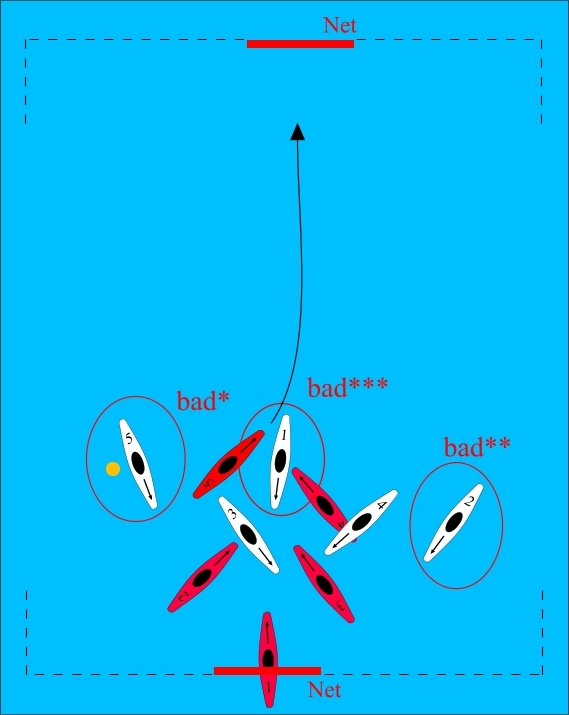
*Player five has manoeuvred such that they are facing goal with no good shot available and no one to pass to.
**Player two cannot receive a pass unless it passes through or over most of the opposition players, they are also facing goal with no good shot available.
***Player one cannot receive a pass and is also facing goal. The combination of all attacking players facing goal with no pass available is likely to lead to a loss in possession, at which point opposition player five can break free, receive a long pass and score an open goal.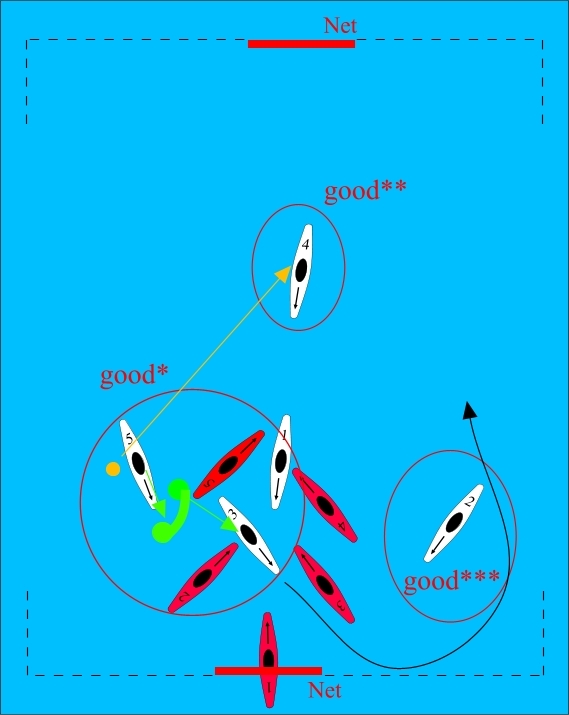
*Player five has passed the ball back out to player four and communicated to player three that they are coming in to attack the zone. Player three can then paddle out of the zone and support player four, while in the process causing disruption and driving defending players across to one side.
**Player four has moved out to provide a link between players two and five, and provide player five with somewhere easy to pass to while attempts to make openings in the opposition defence continue.
***Player two can receive a pass from player four now, and draw players across to one side by 'looking threatening'. If player three manages to drive opposition player three away from goal, player two might be presented with a good shooting opportunity.
Creating openings
Don't be lazy! Everyone wants to score, but this should be the easy part of a well executed attack. The attacking team need to try to create openings in the opposition's defence so that a shooter has a one-on-one shot against the keeper. This takes effort and may seem like a thankless task, especially when someone at the back loses the ball and all your effort was in vain, but persevere! The tips here are a bit idealistic, but have a go and see what happens.
- Try to drive the players defending goal across to open a gap (remembering not to push someone more than 0.5m by sustained contact, this is an illegal 'jostle'.) If possible let the rest of the team know what is happening so that they can get a player to run into the gap, receive a pass and shoot.
- Try to draw players out of defence by feigning attacks and passing the ball around outside of the opposition zone to get the opposition to chase the ball. How well the latter will work depends on the score-line. If they are winning comfortable, they don't need to risk chasing the ball.
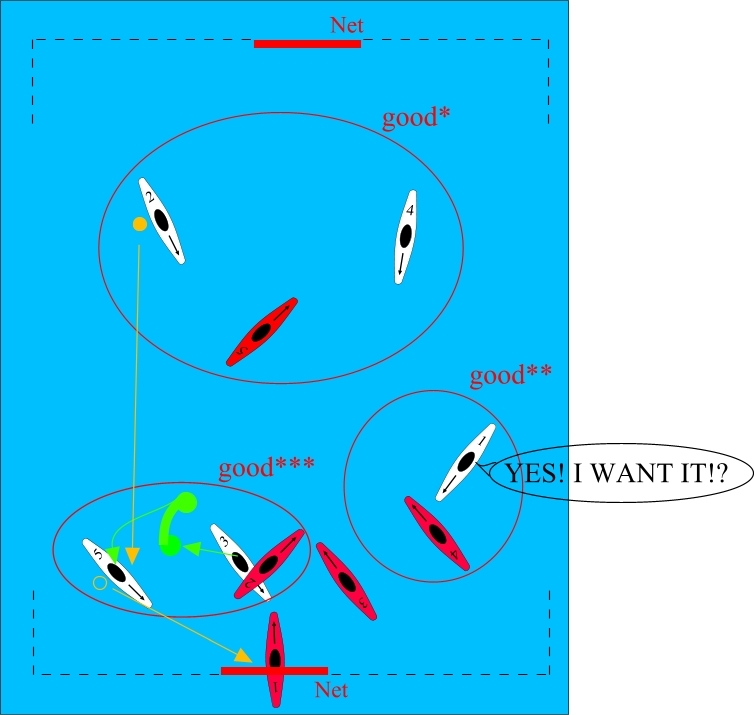
*Players two and four are controlling the ball further down the pitch, drawing opposition player five out of defence to chase the ball.
**Player one has made a diagonal run in and is screaming for the ball (which is ignored by the rest of the attacking team because they know player one has no chance of getting a good shooting opportunity from there). Opposition player four comes across to mark player one and opposition player three is perhaps distracted for a moment.
*** Player three has communicated to player five that they are going to make a run in and drive opposition player two across to the right,�player five sprints in towards goal,�receives a pass from player two and has a�shot at goal from a reasonably good position and probably scores. The whole team created the goal. If they didn't score, players one, two and four are in a good position to cover any counter-attack.
Set piece attack 1 - 'Clear-out
Here is a set piece attack to try. We'll try practising it and see if it works. I don't see why it shouldn't. The diagrams below split it up into two parts.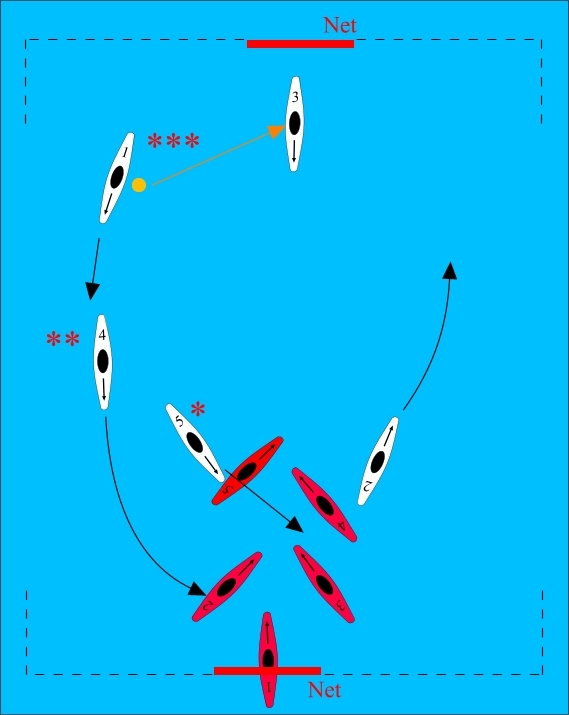
*Player five starts to drive the front two zone players across, and keeps them occupied. Player two has come out from attacking the zone to help player three keep possession of the ball at the back.
**Player four paddles in to start driving the rear two players across and away from their goal line.
***Player one gets rid of the ball and starts following player four at a leisurely pace.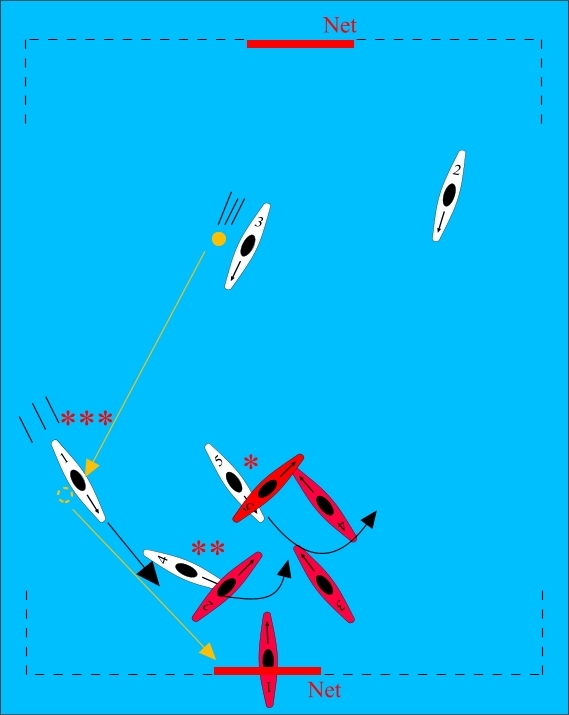
* and ** Players four and five continue driving hard across and out of the opposition zone, trying to occupy the opposition players, create chaos, keep their paddles down in the water etc., while preparing to get out of the zone and back to defence in case of a counter attack.
*** Player one accelerates, approaches the goal from behind player four, at top speed, receives a quick pass from player three and shoots.
GOAL!!!! Maybe...
Set piece attack 2 - 'Corner clear-out'
Here is another set piece attack to try, this time from a corner. We'll try practising it and see if it works. I don't see why it shouldn't. The diagrams below split it up into two parts.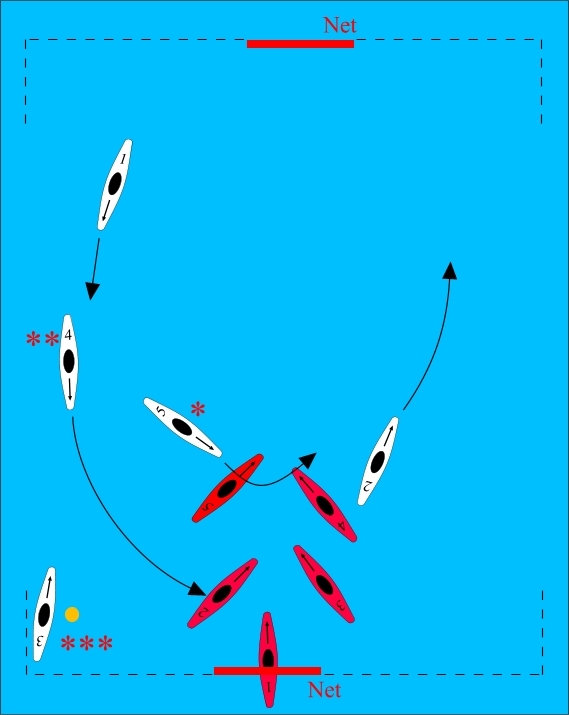
*Player five starts to drive the front two zone players across, and keeps them occupied. Player two has come out from attacking the zone to cover the back. This time, player five tries to finish their drive such that they are in between the zone and their own goal, facing their own goal so that they can easily sprint back to defend if there is a counter attack.
**Player four paddles in to start driving the rear two players across and away from their goal line, also making their way back out in case of counter attack.
***Player one starts paddling down the side of the pitch, behind player four and turns in to sprint diagonally towards goal.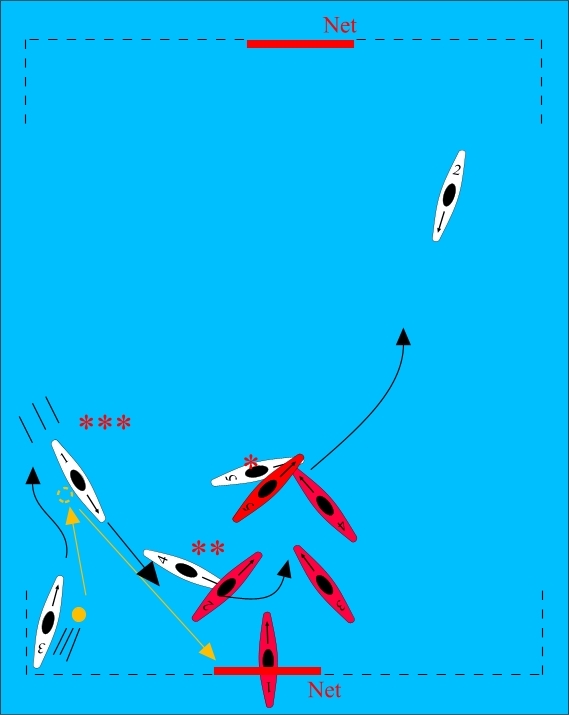
* and ** Players four and five continue driving hard across and out of the opposition zone, trying to occupy the opposition players, create chaos, keep their paddles down in the water etc., while preparing to get out of the zone and back to defence in case of a counter attack.
*** Player one accelerates, approaches the goal from about 45 degrees to the goal line, at top speed, receives a quick pass from player three, who is taking the corner, and shoots.
GOAL!!!! Maybe...
We will experiment with people marking the player taking the corner. The pass from the player in the corner may have to be low and hard to avoid being blocked by any defenders close by.


